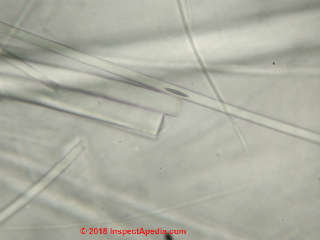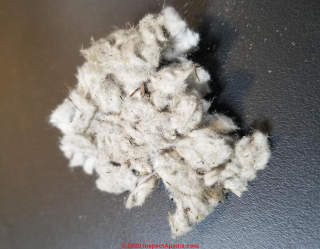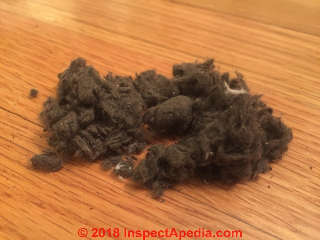 Rock Wool, Stone Wool, Mineral Wool, & Slag Wool Insulation FAQs
Rock Wool, Stone Wool, Mineral Wool, & Slag Wool Insulation FAQs
Q&A on mineral wool or its equivalents
- POST a QUESTION or READ FAQs about Rock Wool mineral fiber insulation
Rock wool or mineral wool insulation identification Q&A.
This mineral wool or "rock wool" insulation article series illustrates and describes mineral wool or "rock wool" and slag wool insulation materials.
InspectAPedia tolerates no conflicts of interest. We have no relationship with advertisers, products, or services discussed at this website.
Mineral wool or "rock wool" or "slag wool" building insulation Q&A
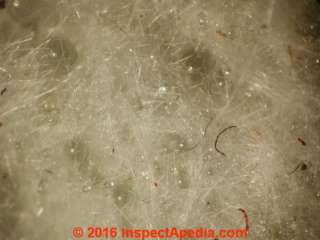 These questions and answers about mineral wool, rock wool, slag wool, were posted originally at MINERAL WOOL - ROCK WOOL INSULATION - be sure to see the information provided there
These questions and answers about mineral wool, rock wool, slag wool, were posted originally at MINERAL WOOL - ROCK WOOL INSULATION - be sure to see the information provided there
On 2021-02-19 - by (mod) - mineral wool insulation in use since 1840
Shaun
Mineral wool insulation has indeed been in use since commercial mineral wool insulation was invented inWales by Edward Perry in 1840. (Bozsaky 2010)
You can read the Bozsaky article in the references above on this page.
On 2021-02-19 by Shaun
Thank you Dan. Most of it was in areas that have been completely sealed since the house was built in 1890.
On 2021-02-18 by (mod) - white mineral wool insulation from an 1890's Pennsylvania Home in the U.S.
Looks like white mineral wool or "rock wool" or "slag wool" insulation.
Mineral wool usually has more gray in it. I see soe gray filaments and some dark inclusions in your insulation; if those are not soiling from the insulation's history then those details argue for mineral wool or slag wool insulation.
We introduce mineral wool in our Insulation Identification guide at at MINERAL WOOL https://inspectapedia.com/insulation/Insulation-Identification-Guide.php#Mineral_Wool
Our full article on the topic is found at MINERAL WOOL - ROCK WOOL INSULATION - above on this page.
This Q&A were posted originally at INSULATION IDENTIFICATION GUIDE
Compare this white insulation with
and with
On 2021-02-18 by Shaun
Additional picture 1890s home Pennsylvania - shown above.
Loose fill insulation? From 1890 home Pennsylvania in a attic space and eaves. Is it wool or something I should be worried about and should have tested.
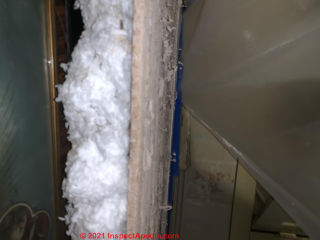
On 2020-10-21 by (mod) - laboratory distinction between mineral wool or "rock wool" and "slag wool" fibres
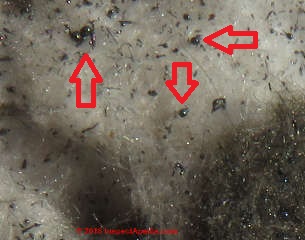 What's the difference between "Rock wool" and "slag wool"
What's the difference between "Rock wool" and "slag wool"
Photo: macro-photograph of slag wool insulation with characteristic globules of blast furnace debris.
[Click to enlarge any image]
Among many suppliers and researchers, the terms "rock wool" and "slag wool" are often both referred to as "mineral wool" without distinguishing variations in the mix of ingredients used in the process by which these fibres are made.
Both of these products use about the same ingredients, basalt rock and blast furnace slag. Their principal difference is the proportions in which their ingredients are mixed.
My photo of slag wool shown here includes red arrows marking the characteristic spheres of slag waste from a blast furnace.
[Click to enlarge any image]
More accurately (and with help from NAIMA cited below):
- Slag wool has as its chief ingredient blast furnace slag, melted to produce fibres, combined with a smaller amount of heated natural rock.
Slag wool will always involve using mostly - up to about 70% slag - material from a blast furnace, a waste product from steel production. Slag wool may also include binders, depending on the specific product and its intended use.
Also see MINERAL WOOL by MICROSCOPE where we have additional photos and information about slag wool insulation.
Also see MINERAL or SLAG WOOL HEALTH EFFECTS where we have more information about slag wool insulation.
- Rock wool has a main ingredient of melted silica (rock), combined with a smaller amount of blast furnace slag.
Rock wool will contain 70 - 75% natural stone (basalt or a similar aluminosilicate rock) to which blast furnace slag waste product is added. Rock wool may also contain binders.
Rockwool is also the trademark of a Danish company who produce stone-based fibrous insulation - as we cite below.
- Mineral wool is a generic term that could describe either of the two products above: rock wool or slag wool, but it is not used to describe not fiberglass products.
- Fiberglass is also a man-made inorganic fibre, produced principally from heating silica (sand), also including limestone and soda ash (used to lower the melting point of the materials). Fiberglass will not contain blast furnace slag.
Fiberglass, depending on the specific manufacturing process, may also include alumina, borax, clay (kaolin), feldspar, nepheline syenite, and magnesite.
These fibres can be readily-identified and can be distinguished from one another by light microscopy in the forensic lab, except that both slag wool and rock wool may look alike.
Alexsandra: regarding our discussion below, I'm glad to assist however I can - trained at McCrone Research in Chicago in forensic microscopy, I too have collected and used reference samples for many years.
I have kept small samples various mineral fibers on hand but have not made the microscopic / forensic distinction by SEM that you are working-on.
Here are a couple of my own lab photos of "mineral wool" provided by JVA, one of our readers, in Lubbock Texas
My first photo, above, shows bits of what I take to be slag debris from a blast furnace - we don't see this in other mineral fibre insulation, and it's trivially easy to see both with the naked eye and under light microscopy.
My second photo, below, shows the characteristic square-cut ends of mineral fibres in mineral wool and slag wool that are distinct from fiberglass fibres (those contain a concoidal fracture at the fibre end.)
I will be grateful for any SEM Photographs of mineral wool, slag wool, and fibreglass fibres that you are able to contribute to this project.
If you don't have local success I may be able to find the original sample of slag wool from which I made the photos above - and would be glad to send it to you.
Notice: Alexsandra's SEM Photographs of rock wool insulation and slag wool insulation are found
at MINERAL WOOL by MICROSCOPE provide images of mineral fibre insulation examined by forensic microscopy and so may be of interest; I would welcome any criticism or content suggestions.
We are working to distinguish and identify two types of mineral wool: stone-wool or "rock wool" versus slag wool insulation.
On 2020-10-21 by Alexsandra
Thank you very much for exhaustive answer! I am obligated to write a little more why I need to purchase slag wool.
I am leading a SEM (scanning electron microscope) project since 2018 in purpose to extend our scope of accreditation and provide analysis for the German market.
Last year we got accreditation for asbestos analysis by SEM. We are accreditied for asbestos analysis in building materials, products and road materials by PLM/TEM in accordance to HSG 248, NFX 43-050 dedicated to french market and SEM in accordance to VDI 3866 part 5 dedicated to german market.
I'm currently working on implementation of artificial mineral fibres analysis by SEM in accordance with VDI 3492 annex D4 guideline. In reference to this standard I should make differences between 3 types of fibres: glass wool, rock wool and slag wool. I wrote to NAIMA last week but unfortunately got negative reply.
Regarding to below tips I will contact institutions. Could you please send once again "inspectapedia" links? It doesn't work and 404 error shows up (we page not found) [now fixed - editor]. Thanks again!
Thank you very much for your support!
On 2020-10-20 - by (mod) - what are the differences between slag wool, rock wool, mineral wool?
Thanks for the discussion, Aleksandra;
You're quite right that slag wool and "rock wool" are confusing terms, and not necessarily chemically identical. Both are mineral fibres but from different base mineral ingredients.
I and many writers and even mineral fiber product distributors have tended to use the term "mineral wool" to describe both rock wool and slag wool - rather loosely as for most applications most users don't make the distinction that you did.
(It would be helpful to know why you are specifically looking for slag wool.)
I, too, had trouble finding "slag wool" as a specific product being marketed in Europe. Below I'm including some current associations whom you might ask for vendor information.
Some of these are U.S. industry associations but I"m researching and will add what I can find in the E.U.
In my OPINION in some countries such as the U.S. slag wool may be less commonly available as its source, slag from industrial processes, specifically or usually iron ore blast furnaces, may not find its way to the insulation industry the way it did 75 years ago. But I definitely see some suppliers who explicitly state that their product is "slag wool".
Also some of the research article authors I cite may be able to steer you to sources, such as Dr. Zhao. And MIMA is in the UK.
Distinctions among Properties of Mineral, Rock, Slag Wool
NAIMA, the North American Insulation Manufacturer's Association offers some text summing up the composition differences between two insulation products.
Watch out : if you read carefully you'll see that the phrase "slag" and "blast furnace slag" appears in their description of rock wool insulation and that "blast furnace slag" appears again in their description of slag wool insulation. As we explained earlier, the difference between rock wool and slag wool is the proportion of their constituents.
Rock wool insulation is composed principally of fibers manufactured from a combination of aluminosilicate rock (usually basalt), blast furnace slag and limestone or dolomite.
Slag wool insulation is composed principally of fibers manufactured by melting the primary component, blast furnace slag, with a combination of some natural rock, with or without binders, depending on the product.
- NAIMA PUB. NO. N046 9/06 cited just below
- International Agency for Research on Cancer. MAN-MADE MINERAL FIBRES AND RADON [PDF] ARC monographs on the evaluation of carcinogenic risks to humans 43 (1988).
- Lockey, James E., and Clara Sue Ross. "Radon and man-made vitreous fibers." Journal of allergy and clinical immunology 94, no. 2 (1994): 310-317.
- MINERAL WOOL by MICROSCOPE provide images of mineral fibre insulation including rock or stone-based insulation and slag-wool insulation, examined by forensic microscopy using transmitted light, polarized light, and SEM or scanning electron microscopy.
- NAIMA, ROCK AND SLAG WOOL INSULATION [PDF] - NAIMA, 44 Canal Center Plaza, Suite 310, Alexandria, VA 22314 USA Phone: 703-684-0084
Excerpt:
"Mineral Wool" is often used generically and is in most definitions described as: "... a non-metallic, inorganic product manufactured from a carefully controlled mix of raw materials, mainly comprising either stone or silica which are heated to a high temperature until molten. The molten glass or stone is then spun and formed into a flexible, fibrous mat for further processing into finished products." - MIMA, Mineral Insulation Manufacturers Association, contact MIMA at: sarah@mima.info Tel: +44 (0)20 7293 0870 http://mima.info/about-mineral-wool/what-is-mineral-wool/
- Plato, Nils, Staffan Krantz, Per Gustavsson, Thomas J. Smith, and Peter Westerholm. "Fiber exposure assessment in the Swedish rock wool and slag wool production industry in 1938—1990." Scandinavian journal of work, environment & health (1995): 345-352.
- Zhao, Dawei, Zuotai Zhang, Xulong Tang, Lili Liu, and Xidong Wang, PREPARATION OF SLAG WOOL BY INTEGRATED WASTE-HEAT RECOVERY AND RESOURCE RECYCLING OF MOLTEN BLAST FURNACE SLAGS: from fundamental to industrial application. [PDF] Energies 7, no. 5 (2014): 3121-3135.
On 2020-10-20 by Aleksandra
Correct I am in Europe and looking for slag wool not rock wool as there are differences between them (chemical composition). Now I am looking in USA and India market but unfortunately I got negative results (couldn't find it). I bought rock wool without a problem (the link you send is rock wool). I work in enviromental laboratory taht why I has so specific requirements .
I would grateful for any information :)
I forgot to add I am from Poland but it doesn't matter. We can purchase wherever we want as company.
On 2020-10-16 - by (mod) - where to buy Slag Wool Insulation
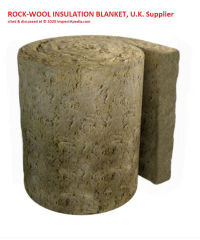 Alexsandra
Alexsandra
Where are you in Europe?
There are quite a few mineral wool or "rock wool" suppliers, for example, in the U.K. (heaven help us with this transaction post Brexit).
- https://www.rockwool.co.uk/
- https://www.insulationsuperstore.co.uk/browse/insulation/loft-insulation/mineral-wool.html (illustrated below)
- https://www.insulationsuperstore.co.uk/brand/rockwool.html
On 2020-10-16 by Aleksandra
Where can I buy slag wool? I cannot find it in Europe. My laboratory need it as reference material.
On 2020-10-09 - by (mod) - electrician mistakes mineral wool for asbestos
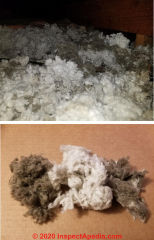 That is not asbestos building insulation.
That is not asbestos building insulation.
It looks like mineral wool
Unfortunately if you got into an argument with your insurance company will need get an independent lab result.
You should also review
ASBESTOS IN MINERAL WOOL / STONE WOOL
On 2020-10-09 by Robert
Hello and thanks for your wonderful website.
We live north of Napa, CA in the mountains by a lake. Our ranch style home was built in the mid-60s. We recently had an electrician over to look at a problem in our attic.
When he opened the access hatch, he saw this type of insulation all over the attic (see attached picture) and immediately proclaimed that it is, or contains, asbestos.
He refused to go any further into the attic to troubleshoot the electrical wiring. The next morning, he called and said he saw some pictures on the web and claims that he's positive that it's asbestos, but not 100% sure.
What's upsetting is that he had mentioned this to our insurance company.
Even though as an electrician he may have come across all different kinds of insulation, but he's no expert on asbestos insulation. Especially since he only glanced at it for less than a few seconds before passing judgment and rushing back down the ladder.
I, on the other hand, after finding your website and reading the excellent articles and Q&As, and looking at all the excellent pictures, am thinking that the insulation is mineral wool or rock wool.
But I too am not certain. I will greatly appreciate your expert opinion as to what type of insulation it might be and whether it might contain asbestos. I'd like to get your expert input before buying a testing kit and sending the samples to a lab in order to satisfy our insurance company.
On 2020-06-06 - by (mod) -
Dwayne
Try the add image button, and you can post one photo per comment. I look forward to seeing your insulation and will be glad to commen further.
On 2020-06-06 by Dwayne
This is insulation which was found during the renovation of our home which was built in 1948. There was black paper on the under side of batt sections nailed to the ceiling. The layers of paper which are brown-ish in color were layered. I'm very curious about this material. Is it Mineral Wool? Does it contain asbestos?
On 2020-05-24 by Konrad
Hello,
Excellent article. Could you tell me if this looks like rock fiber; its itchy like fiberglass. It's blown in insulation in the rafters of my attic. The house was built in 1934.
On 2020-08-02 - by (mod) - mineral wool or rock wool in a 1920s Canadian home
Looks like mineral wool.
On 2020-08-02 by clifford - white fibrous insulation in a 1920s Canadian home
Hi - any thoughts on what this might be? [photo above]
In an attic, house built ~1920 in Ontario, Canada; attic may have been insulated in a reno dating sometime between then and 1970ish
Question: what is this insulation material?
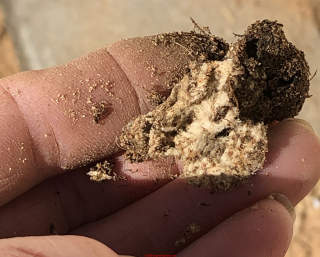 Last year we pulled out a bunch of loose insulation (2or3 different kinds) I know newspaper was one of the kinds.
Last year we pulled out a bunch of loose insulation (2or3 different kinds) I know newspaper was one of the kinds.
Some of it ended up in my compost pile and the newspaper I don’t mind but the stuff that looks like cotton has not broken down after more than a year!
I was hoping to find out (by doing some web research) what kind exactly it was and if it would be dangerous to leave in the compost if it’s toxic or fiberglass or something
I’ve been looking for quite a while now I can’t seem to find exactly what I’ve got! the house was built back in the 40s,
don’t know exactly how old the insulation is though I know it’s more than five years old
So here’s a picture of what I’m dealing with if you can help me identify it I would [be grateful] - Anonymous by private email 2020/02/04
Reply:
That looks like mineral wool insuation, Anon.
If so, it won't deterioriate on a compost pile as it's a mineral fibre not an organic material.
On 2019-07-23 by (mod) -
Mark
We do not recommend specific products - wanting to keep at arm's length in order to protect reader trust - with the rare exception of there being perhaps only a single specific product available in the first place.
Just about any mineral wool product is going to have nearly-identical properties. What matters then is the workmanship of the installer. You might look for local references for installers in your area.
On 2019-07-23 by markbgoldstone@gmail.com
What blown in rock wool product do you recommend to insulate a ceiling in a two family house between the first and second two floors for sound reduction purposes?
The house likely has cross bracing between floor joists.
On 2018-02-10 by rockwool
The text was great thanks.
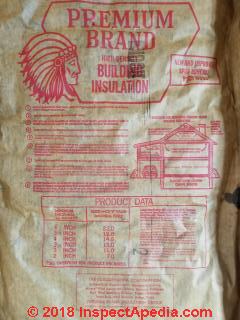 On 2018-06-08 by (mod) - does this insulation contain asbestos?
On 2018-06-08 by (mod) - does this insulation contain asbestos?
David,
The text on the kraft facing of your insulation identifies it as mineral wool - a synonym for "rock wool". That is not an asbestos product.
see MINERAL WOOL / "Rock Wool" COMPOSITION
Trudy and David:
Check out MINERAL WOOL / STONE WOOL ASBESTOS CONTENT as that's my most-informed answer to the asbestos-in-rockwool question
Let me know if you have questions after seeing that and I'll be glad to research further.
On 2018-06-07 by David
Does anyone know if this insulation contains asbestos?
On 2017-07-22 Trudy cress
Sorry it was gla gyproc wool not agl
Any chance Agl gyproc wool home and building insulation contains asbestos found in Canadian home built in 1970's
On 2016-01-24 by (mod) - Johns Manville patent for Rock Wool
John,
The Johns Manville patent you cite is described as follows:
This invention relates to an improved heat insulating product and with regard to certain other features to an improved felted and/or laminated product composed of rock or mineral
wool.
That's mineral wool, not asbestos.
See
Powell, Edward R. "Heat insulating product and method of forming same." U.S. Patent 1,928,264, issued September 26, 1933.
On 2016-01-14 by John Khalil
I have some Johns Manville insulation in my basement that has patent #1928264 on the facing material. I believe it is mineral or rock wool. I want to make sure it does not contain asbestos.
On 2015-06-25 by P. Merrill
In reference to original question---line 3---"below a bold straight..in Spanish". It should have read, "below a bold straight LINE in Spanish language. ( I don't know what year manufacturers were required to include instructions in Spanish)
Think we bought maybe at a Hugh M. Woods or Home Base, possibly more recently 10-15 yrs ago at Home Depot.
The backing looks like light colored brown paper bag material and the insulation itself is light butter color. "gold fiber glass building insulation" in lower case lettering that is dark tan in color with the same info appearing below a bold straight.. in Spanish.
We are guessing it's fiberglass which is itchy but would like assurance there is no asbestos. We need to move (1) batt to get at a leak in a black waste water pipe from upstairs kitchen drain. The water is leaking onto top on foundation sill then down across a stretch of basement wall causing a big puddle.
We are original owners of a "Woods Bros." tract home bought in 1973 for 25,000.00 in Aurora, Co. Any insights into asbestos question would be very appreciated.
Question: Should I remove old rock wool batts when adding insulation to my attic?
I am planning to have the attic of my house. built in 1950 covered with blown-in fiberglass (up to R-45). It currently has old rock wool batts with paper on the top and bottom. Should I have them removed first? Is there a fire or moisture hazard if I keep it and put the fiberglass on top? - Gabe
Reply: old insulation can be left in place if clean; don't create multiple vapor barriers when adding more.
Gabe, if the old insulation is clean (not full of mouse pee, etc), you can leave it in place; The moisture hazard won't be changed by adding blown-in fiberglass as that addition won't add another moisture barrier; If the moisture barrier (kraft paper) on the TOP (attic up side) of your existing bats is not already perforated you could slash it to be sure it does not continue to form a potential moisture trap;
Question: I'm looking for mineral wool to insulate the exterior of a slab
looking for mineral wool that is for exterior slab insulation made in washington state - Warren Powell
Reply: Fiber-based insulation is not the best choice for the exterior of building slabs and foundations
Mr. Powell in my OPINION mineral wool would be an inappropriate insulating material to place on the outside of a concrete slab. Even if you constructed something to hold the mineral wool in place against the slab edges, the water would promptly penetrate the insulation leaving it's R-value virtually nil.
You could construct an absolutely waterproof container to hold the mineral wool, but I would be left wondering why such a labor intensive and costly slab insulation method was preferable to solid foam insulation. What am I missing?
Question: history of the requirement for building insulation
Was the insulation "Optional" when building a house back in the 50's or was there a minimum requirement to meet? - Horacio
Reply: general building insulation was not code specified in many U.S. jurisdictions before the energy crisis of the 1970's but some codes requiring insulation date back at least to the 1920's in the U.S.
Horacio.
When researching national building insulation standards II suspect we'll find some early references in HUD and VA housing legislation and standards, the history of building codes, and much more recently the model energy codes.But what was required locally in your immediate area could be a very different story.
Keep in mind that building codes and standards vary in different countries, states or provinces, and smaller jurisdictions.
Using Seattle WA building code history as an example we noted that some insulation requirements date as far back as 1927 (heating duct insulation). But the Seattle building codes did not specifically require insulation until 1974, and the city's model energy code was not adopted until 1980. [1]
As we introduced above, insulation was probably "optional" in the 1950's in at least some building jurisdictions. One would need to research a more specific history for your own location.
Question: insulation standards for homes built in the 1950's
(Dec 8, 2011) Horacio Gonzalez said:
Was the insulation "Optional" when building a house back in the 50's or was there a minimum requirement to meet?
(June 28, 2014) Insulation codes said:
Do you know where I might find a list of insulation codes or minimums for Washington State from the 1970's to present?
Reply:
Good question Horacio. We'd have to do some further research on what building standards in what years began requiring insulation but here is a basic reply.
I suspect we'll find some early references in HUD and VA housing legislation and standards, the history of building codes, and much more recently the model energy codes. Keep in mind that building codes and standards vary in different countries, states or provinces, and smaller jurisdictions.
Using Seattle WA building code history as an example we noted that some insulation requirements date as far back as 1927 (heating duct insulation). But the Seattle building codes did not specifically require insulation until 1974, and the city's model energy code was not adopted until 1980. [Ref. Seattle [dot] gov ]
As I've introduced above, insulation was probably "optional" in the 1950's in at least some building jurisdictions. One would need to research a more specific history for your own location.
Question:
(Mar 17, 2013) aaron said:
i am remodeling the upstairs of my "cape cod" built in 1945. the walls are made of what appears to be sheets of pressed-fiber cardboard 1/2" thick. is this harmful?
Reply:
Aaron,
Search InspectApedia for
Homasote or Beaverboard to read about what I suspect is the material you describe
Question: exposed insulation at building exterior brick veneer walls (leaks)
(July 6, 2014) Jacopo said:
Hi, the space between the external frame of my back door and the wall has in some places the coating (gypsum I'm guessing) peeling off and below it I can see some wood and some wool-like substance. Am I right in assuming it is mineral wool and not something dangerous like asbestos? Here's a couple of pictures ...
Reply:
Jacopo
I looked at your photos and saw what looks like the edge of a brick veneer. The actual insulation was quite difficult to make out, but I saw what looked like pink fiberglass.
Certainly having the wall cavity open to the weather is asking for problems with mold, insects, rot, water damage.
Reader follow-up:
It is indeed between a brick wall and the wooden doorframe, and the insulation does look white-pinkish.
Sorry for the links! Is there any other way to make pictures accessible in comments? In any case I have taken a couple more, hopefully clearer and denser in pixels, pictures of the insulation.
Reply:
Your photos show pink fiberglass building insulation. My earlier warnings are more important than the kind of insulating material.
(July 7, 2014) Jacopo said:
Thanks again! I'll be sure to alert my landlord
These questions & replies about rockwool insulation were posted originally at MINERAL WOOL - ROCK WOOL INSULATION - be sure to review that article
On 2018-02-10 by rockwool
The text was great thanks.
 On 2018-06-08 by (mod) - does this insulation contain asbestos?
On 2018-06-08 by (mod) - does this insulation contain asbestos?
David,
The text on the kraft facing of your insulation identifies it as mineral wool - a synonym for "rock wool". That is not an asbestos product.
see MINERAL WOOL / "Rock Wool" COMPOSITION
Trudy and David:
Check out MINERAL WOOL / STONE WOOL ASBESTOS CONTENT as that's my most-informed answer to the asbestos-in-rockwool question
Let me know if you have questions after seeing that and I'll be glad to research further.
On 2018-06-07 by David
Does anyone know if this insulation contains asbestos?
On 2017-07-22 Trudy cress
Sorry it was gla gyproc wool not agl
Any chance Agl gyproc wool home and building insulation contains asbestos found in Canadian home built in 1970's
On 2016-01-24 by (mod) - Johns Manville patent for Rock Wool
John,
The Johns Manville patent you cite is described as follows:
This invention relates to an improved heat insulating product and with regard to certain other features to an improved felted and/or laminated product composed of rock or mineral
wool.
That's mineral wool, not asbestos.
See
Powell, Edward R. "Heat insulating product and method of forming same." U.S. Patent 1,928,264, issued September 26, 1933.
On 2016-01-14 by John Khalil
I have some Johns Manville insulation in my basement that has patent #1928264 on the facing material. I believe it is mineral or rock wool. I want to make sure it does not contain asbestos.
On 2015-06-25 by P. Merrill
In reference to original question---line 3---"below a bold straight..in Spanish". It should have read, "below a bold straight LINE in Spanish language. ( I don't know what year manufacturers were required to include instructions in Spanish)
Think we bought maybe at a Hugh M. Woods or Home Base, possibly more recently 10-15 yrs ago at Home Depot.
The backing looks like light colored brown paper bag material and the insulation itself is light butter color. "gold fiber glass building insulation" in lower case lettering that is dark tan in color with the same info appearing below a bold straight.. in Spanish.
We are guessing it's fiberglass which is itchy but would like assurance there is no asbestos. We need to move (1) batt to get at a leak in a black waste water pipe from upstairs kitchen drain. The water is leaking onto top on foundation sill then down across a stretch of basement wall causing a big puddle.
We are original owners of a "Woods Bros." tract home bought in 1973 for 25,000.00 in Aurora, Co. Any insights into asbestos question would be very appreciated.
Question: Should I remove old rock wool batts when adding insulation to my attic?
I am planning to have the attic of my house. built in 1950 covered with blown-in fiberglass (up to R-45). It currently has old rock wool batts with paper on the top and bottom. Should I have them removed first? Is there a fire or moisture hazard if I keep it and put the fiberglass on top? - Gabe
Reply: old insulation can be left in place if clean; don't create multiple vapor barriers when adding more.
Gabe, if the old insulation is clean (not full of mouse pee, etc), you can leave it in place; The moisture hazard won't be changed by adding blown-in fiberglass as that addition won't add another moisture barrier; If the moisture barrier (kraft paper) on the TOP (attic up side) of your existing bats is not already perforated you could slash it to be sure it does not continue to form a potential moisture trap;
Question: I'm looking for mineral wool to insulate the exterior of a slab
looking for mineral wool that is for exterior slab insulation made in washington state - Warren Powell
Reply: Fiber-based insulation is not the best choice for the exterior of building slabs and foundations
Mr. Powell in my OPINION mineral wool would be an inappropriate insulating material to place on the outside of a concrete slab. Even if you constructed something to hold the mineral wool in place against the slab edges, the water would promptly penetrate the insulation leaving it's R-value virtually nil.
You could construct an absolutely waterproof container to hold the mineral wool, but I would be left wondering why such a labor intensive and costly slab insulation method was preferable to solid foam insulation. What am I missing?
Question: history of the requirement for building insulation
Was the insulation "Optional" when building a house back in the 50's or was there a minimum requirement to meet? - Horacio
Reply: general building insulation was not code specified in many U.S. jurisdictions before the energy crisis of the 1970's but some codes requiring insulation date back at least to the 1920's in the U.S.
Horacio.
When researching national building insulation standards II suspect we'll find some early references in HUD and VA housing legislation and standards, the history of building codes, and much more recently the model energy codes.But what was required locally in your immediate area could be a very different story.
Keep in mind that building codes and standards vary in different countries, states or provinces, and smaller jurisdictions.
Using Seattle WA building code history as an example we noted that some insulation requirements date as far back as 1927 (heating duct insulation). But the Seattle building codes did not specifically require insulation until 1974, and the city's model energy code was not adopted until 1980. [1]
As we introduced above, insulation was probably "optional" in the 1950's in at least some building jurisdictions. One would need to research a more specific history for your own location.
Question: insulation standards for homes built in the 1950's
(Dec 8, 2011) Horacio Gonzalez said:
Was the insulation "Optional" when building a house back in the 50's or was there a minimum requirement to meet?
(June 28, 2014) Insulation codes said:
Do you know where I might find a list of insulation codes or minimums for Washington State from the 1970's to present?
Reply:
Good question Horacio. We'd have to do some further research on what building standards in what years began requiring insulation but here is a basic reply.
I suspect we'll find some early references in HUD and VA housing legislation and standards, the history of building codes, and much more recently the model energy codes. Keep in mind that building codes and standards vary in different countries, states or provinces, and smaller jurisdictions.
Using Seattle WA building code history as an example we noted that some insulation requirements date as far back as 1927 (heating duct insulation). But the Seattle building codes did not specifically require insulation until 1974, and the city's model energy code was not adopted until 1980. [Ref. Seattle [dot] gov ]
As I've introduced above, insulation was probably "optional" in the 1950's in at least some building jurisdictions. One would need to research a more specific history for your own location.
Question:
(Mar 17, 2013) aaron said:
i am remodeling the upstairs of my "cape cod" built in 1945. the walls are made of what appears to be sheets of pressed-fiber cardboard 1/2" thick. is this harmful?
Reply:
Aaron,
Search InspectApedia for
Homasote or Beaverboard to read about what I suspect is the material you describe
Question: exposed insulation at building exterior brick veneer walls (leaks)
(July 6, 2014) Jacopo said:
Hi, the space between the external frame of my back door and the wall has in some places the coating (gypsum I'm guessing) peeling off and below it I can see some wood and some wool-like substance. Am I right in assuming it is mineral wool and not something dangerous like asbestos? Here's a couple of pictures ...
Reply:
Jacopo
I looked at your photos and saw what looks like the edge of a brick veneer. The actual insulation was quite difficult to make out, but I saw what looked like pink fiberglass.
Certainly having the wall cavity open to the weather is asking for problems with mold, insects, rot, water damage.
Reader follow-up:
It is indeed between a brick wall and the wooden doorframe, and the insulation does look white-pinkish.
Sorry for the links! Is there any other way to make pictures accessible in comments? In any case I have taken a couple more, hopefully clearer and denser in pixels, pictures of the insulation.
Reply:
Your photos show pink fiberglass building insulation. My earlier warnings are more important than the kind of insulating material.
(July 7, 2014) Jacopo said:
Thanks again! I'll be sure to alert my landlord
...
...
Continue reading at MINERAL WOOL - ROCK WOOL INSULATION - home or select a topic from closely-related articles below, or see our complete INDEX to RELATED ARTICLES below.
Or see these
Recommended Articles
- ASBESTOS IN MINERAL WOOL / STONE WOOL
- CAREY ROCK WOOL CATALOG 1950 [PDF]
- INSULATION IDENTIFICATION GUIDE - home
- MINERAL WOOL - ROCK WOOL INSULATION
- home
- MINERAL WOOL / ROCK WOOL DEFINITIONS
- MINERAL WOOL / "Rock Wool" COMPOSITION
- MINERAL WOOL / STONE WOOL ASBESTOS CONTENT
- MINERAL WOOL APPEARANCE VARIATIONS
- MINERAL / SLAG WOOL AIRBORNE PARTICLES
- MINERAL / ROCK WOOL INSTALLATION, SETTLING
- MINERAL WOOL / STONE WOOL R-VALUES
- MINERAL or SLAG WOOL HEALTH EFFECTS
- MINERAL WOOL by MICROSCOPE
Suggested citation for this web page
MINERAL WOOL - ROCK WOOL INSULATION at InspectApedia.com - online encyclopedia of building & environmental inspection, testing, diagnosis, repair, & problem prevention advice.
Or see this
INDEX to RELATED ARTICLES: ARTICLE INDEX to BUILDING INSULATION
Or use the SEARCH BOX found below to Ask a Question or Search InspectApedia
Ask a Question or Search InspectApedia
Try the search box just below, or if you prefer, post a question or comment in the Comments box below and we will respond promptly.
Search the InspectApedia website
Note: appearance of your Comment below may be delayed: if your comment contains an image, photograph, web link, or text that looks to the software as if it might be a web link, your posting will appear after it has been approved by a moderator. Apologies for the delay.
Only one image can be added per comment but you can post as many comments, and therefore images, as you like.
You will not receive a notification when a response to your question has been posted.
Please bookmark this page to make it easy for you to check back for our response.
Our Comment Box is provided by Countable Web Productions countable.ca
Citations & References
In addition to any citations in the article above, a full list is available on request.
- Cummings, J. M. "Possibilities for the Manufacture of Mineral Wool in British Columbia" [PDF], British Columbia Department of Mines, (1937)- includes tables comparing properties of various insulation and other materials to mineral wool and balsam wool, retrieved 12/6/2014, original source: http://142.32.76.167/Mining/Geoscience/ PublicationsCatalogue/MiscellaneousPublications/ Documents/PossibilitiesManufactureMineralWool1937.pdf
- [1] Seattle Energy Code, Seattle Energy Code History, web search 12/6/2011, original source: http://www.seattle.gov/dpd/Codes/Energy_Code/Overview/history.asp
- Adams, P. "Effects of increasing the salinity of the nutrient solution with major nutrients or sodium chloride on the yield, quality and composition of tomatoes grown in rockwool." Journal of Horticultural Science 66, no. 2 (1991): 201-207.
- Awang, Y. B., J. G. Atherton, and A. J. Taylor. "Salinity effects on strawberry plants grown in rockwool. I. Growth and leaf water relations." Journal of Horticultural Science 68, no. 5 (1993): 783-790.
- Awang, Yahya B., and J. G. Atherton. "Growth and fruiting responses of strawberry plants grown on rockwool to shading and salinity." Scientia Horticulturae 62, no. 1 (1995): 25-31.
- Eparvier, Agnès, Philippe Lemanceau, and Claude Alabouvette. "Population dynamics of non-pathogenic Fusarium and fluorescent Pseudomonas strains in rockwool, a substratum for soilless culture." FEMS Microbiology Letters 86, no. 2 (1991): 177-184.
Abstract
In soilless cropping systems, soil-borne plant pathogens, especially Fusarium oxysporum, are responsible for severe damage in vegetable and flower cultures. Non-pathogenic Fusarium and fluorescent Pseudomonas are able to control fusarium diseases, thereby increasing the yield. The association of the non-pathogenic Fusarium strain Fo47 and of the fluorescent Pseudomonas strain C7R12 gave a better control of fusarium diseases compared to single inoculations of each antagonistic microorganism.
So far, no data have been available on the survival of these two microorganisms in soilless growing substrate. The results of this study indicate that both microorganisms survive well in rockwool when inoculated alone or together as well as in the absence or the presence of plants. Under the present experimental conditions, a single application of the antagonists appears to be enough to get a significant control of fusarium wilts. - Fonteno, William C., and Paul V. Nelson. "Physical properties of and plant responses to rockwool-amended media." Journal of the American Society for Horticultural Science 115, no. 3 (1990): 375-381.
Abstract:
Loose rockwool had a total porosity similar to peatmoss (92%, by volume) but with water retention capabilities similar to sand. Root media formulations containing loose rockwool were tested with seven plant species for plant response and nutrient uptake. The volume percent formulation, 20 rockwool : 10 peatmoss : 20 vermiculite : 45 pine bark : 5 perlite, was superior to formulations containing 10% or 30% rockwool. Plant response in this rockwool medium in bedding plant flats was superior to that in two high-performing commercial media for impatiens (Impatiens sultanii Hook), marigold (Tagetes patula L.), and petunia (Petunia hybrida Vilm) and equal to one commercial medium for tomato (Lycopersicon esculentum Mill.).
However, response of chrysanthemum (Chrysanthemum × morifolium Ramat.), geranium (Pelargonium × hortorum Bailey), and poinsettia (Euphorbia pulcherrima Willd. ex Kl.) in 1.58-liter pots was inferior to both commercial media in one-half of the trials. Differential plant responses in the root media treatments did not relate directly to differences found to occur in plant nutrient composition. The high initial pH level of rockwool necessitated reduced application of limestone and increased application of calcium sulfate to offset Ca deficiency. - Fuchs, J-G., Y. Moënne-Loccoz, and G. Défago. "Nonpathogenic Fusarium oxysporum strain Fo47 induces resistance to Fusarium wilt in tomato." Plant Disease 81, no. 5 (1997): 492-496.
- Galera, Melvin Maaliw, Eulsaeng Cho, Enkhdul Tuuguu, Shin-Jung Park, Changhee Lee, and Wook-Jin Chung. "Effects of pollutant concentration ratio on the simultaneous removal of NH 3, H 2 S and toluene gases using rock wool-compost biofilter." Journal of Hazardous Materials 152, no. 2 (2008): 624-631.
Abstract:
The need to find economically and environmentally more viable methods for the management of industrial wastes has opened the way to the research and development of processes which were still in the laboratory only a few years ago. The examples given concern two very common and acutely-felt problems: the inertization and recycling of hydrometallurgical red muds (RM) and of mine tailings.
In the case of red mud, one potential process involves the extraction of metals (mainly Zn, but also Cd, Sn, Ph, Fe), and another involves mixing the RM with granite chippings and cullet to produce glass-ceramics materials via melting and crystallization.
The paper also discusses a new flowsheet in which mine tailings are utilized to produce either glass-wool or very strong glass-ceramic products, with good resistance to chemical attack. - Kim, K-A., W. K. Lee, J. K. Kim, M-S. Seo, Y. Lim, K-H. Lee, G. Chae, S-H. Lee, and Y. Chung. "Mechanism of refractory ceramic fiber-and rock wool-induced cytotoxicity in alveolar macrophages." International archives of occupational and environmental health 74, no. 1 (2000): 9-15.
- Leeman, M., J. A. Van Pelt, F. M. Den Ouden, M. Heinsbroek, P. A. H. M. Bakker, and B. Schippers. "Induction of systemic resistance byPseudomonas fluorescens in radish cultivars differing in susceptibility to fusarium wilt, using a novel bioassay." European Journal of Plant Pathology 101, no. 6 (1995): 655-664.
- Marabini, Anna Maria, Paolo Plescia, Dante Maccari, Francesco Burragato, and Mario Pelino. "New materials from industrial and mining wastes: glass-ceramics and glass-and rock-wool fibre." International journal of mineral processing 53, no. 1 (1998): 121-134.
Abstract:
The need to find economically and environmentally more viable methods for the management of industrial wastes has opened the way to the research and development of processes which were still in the laboratory only a few years ago. The examples given concern two very common and acutely-felt problems: the inertization and recycling of hydrometallurgical red muds (RM) and of mine tailings. In the case of red mud, one potential process involves the extraction of metals (mainly Zn, but also Cd, Sn, Ph, Fe), and another involves mixing the RM with granite chippings and cullet to produce glass-ceramics materials via melting and crystallization. The paper also discusses a new flowsheet in which mine tailings are utilized to produce either glass-wool or very strong glass-ceramic products, with good resistance to chemical attack. - Marsh, G., R. Stone, A. Youk, T. Smith, M. Quinn, V. Henderson, L. Schall, L. Wayne, and K. Lee. "Mortality among United States rock wool and slag wool workers: 1989 update." JOURNAL OF OCCUPATIONAL HEALTH AND SAFETY AUSTRALIA AND NEW ZEALAND 12 (1996): 297-312.
- McCullagh, M., R. Utkhede, J. G. Menzies, Z. K. Punja, and T. C. Paulitz. "Evaluation of plant growth-promoting rhizobacteria for biological control of Pythium root rot of cucumbers grown in rockwool and effects on yield." European Journal of Plant Pathology 102, no. 8 (1996): 747-755.
- Mihuta-Grimm, L., W. A. Erb, and R. C. Rowe. "Fusarium crown and root rot of tomato in greenhouse rock wool systems: sources of inoculum and disease management with benomyl." Plant disease 74, no. 12 (1990): 996-1002.
- Postma, Joeke, Margarit JEIM Willemsen-de Klein, and Jan Dirk van Elsas. "Effect of the indigenous microflora on the development of root and crown rot caused by Pythium aphanidermatum in cucumber grown on rockwool." Phytopathology 90, no. 2 (2000): 125-133.
- Olympios, C. M. "Soilless media under protected cultivation rockwool, peat, perlite and other substrates." In Symposium on Soil and Soilless Media under Protected Cultivation in Mild Winter Climates 323, pp. 215-234. 1992.
- Savvas, D., and F. Lenz. "Effects of NaCl or nutrient-induced salinity on growth, yield, and composition of eggplants grown in rockwool." Scientia Horticulturae 84, no. 1 (2000): 37-47.
- Smith, Denis. Rockwool in horticulture. Grower Books, 1987.
- 3/07: thanks to Gary Randolph, Ounce of Prevention Home Inspection, LLC Buffalo, NY, for attentive reading and editing suggestions. Mr. Randolph can be reached in Buffalo, NY, at (716) 636-3865 or email: gary@ouncehome.com
- Our recommended books about building & mechanical systems design, inspection, problem diagnosis, and repair, and about indoor environment and IAQ testing, diagnosis, and cleanup are at the InspectAPedia Bookstore. Also see our Book Reviews - InspectAPedia.
- In addition to citations & references found in this article, see the research citations given at the end of the related articles found at our suggested
CONTINUE READING or RECOMMENDED ARTICLES.
- Carson, Dunlop & Associates Ltd., 120 Carlton Street Suite 407, Toronto ON M5A 4K2. Tel: (416) 964-9415 1-800-268-7070 Email: info@carsondunlop.com. Alan Carson is a past president of ASHI, the American Society of Home Inspectors.
Thanks to Alan Carson and Bob Dunlop, for permission for InspectAPedia to use text excerpts from The HOME REFERENCE BOOK - the Encyclopedia of Homes and to use illustrations from The ILLUSTRATED HOME .
Carson Dunlop Associates provides extensive home inspection education and report writing material. In gratitude we provide links to tsome Carson Dunlop Associates products and services.



